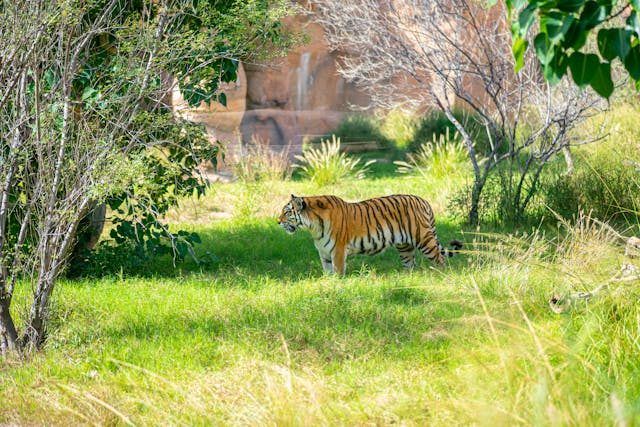Satkosia Ready for Tiger Reintroduction: Awaiting Final Government Approval

Overview of Satkosia Tiger Reserve
Established in 2007, the Satkosia Tiger Reserve is a significant ecological area located in the Angul and Nayagarh districts of Odisha, India. Spanning approximately 963 square kilometers, the reserve is renowned for its stunning landscapes characterized by the dramatic gorges of the Mahanadi River. This river not only enhances the aesthetic value of the reserve but also supports a rich biodiversity that includes various species of flora and fauna. The surrounding ecosystems, such as the tropical dry deciduous forests, contribute to the unique ecological balance within the area.
One of the primary goals of the Satkosia Tiger Reserve is to safeguard the Bengal tiger (Panthera tigris) which was historically a dominant species in the region. However, due to factors such as poaching and increasing human-animal conflicts, the tiger population has faced a significant decline over the years. These ecological challenges have adversely affected the tiger’s status within the reserve. As of now, the reserve has reportedly been devoid of tigers for a considerable period, raising concerns among conservationists and wildlife enthusiasts.
In addition to tigers, Satkosia is home to a plethora of wildlife, including species such as Indian leopards, wild boars, and numerous bird species, making it an important area for biodiversity conservation. The reserve is also significant for local communities as it provides ecosystem services that directly impact their livelihoods. Understanding the intricate relationship between humans and wildlife within this area is vital for effective conservation strategies. With the anticipation of a tiger reintroduction program underway, Satkosia Tiger Reserve is hoping to restore the natural balance of its ecosystem and revive its once-thriving tiger population.
Reasons for Tiger Reintroduction
The reintroduction of tigers in Satkosia is motivated by several critical factors that encapsulate both ecological and conservation imperatives. One significant reason is the alarming decline in the tiger population across their historical range, resulting in a fragmented habitat that poses risks to biodiversity. Tigers play a vital role as apex predators, maintaining the balance within their ecosystems. The absence of these majestic felines can lead to overpopulation of herbivores, causing adverse effects on vegetation and overall biodiversity.
Reflecting on previous initiatives, particularly the 2018 tiger reintroduction effort, it is essential to learn from past failures. The earlier attempts suffered from inadequate ecosystem preparation and insufficient community engagement, which contributed to the unsuccessful outcomes. This time, the strategy has evolved, focusing not only on direct reintroduction plans but also on substantial preparatory measures. These measures include enhancing prey density, conducting habitat assessments, and implementing community awareness programs to foster positive interactions between local populations and wildlife.
Moreover, the Satkosia forest department has undertaken initiatives aimed at creating a robust ecosystem to support the tigers. This includes habitat restoration through reforestation efforts and providing legal protections against poaching, ensuring a secure environment for the new tiger populace. The importance of restoring the tiger population in Satkosia extends beyond mere numbers; it is about reviving ecological integrity. A healthy tiger population can serve as a strong indicator of ecosystem health, motivating broader wildlife conservation efforts and promoting environmental awareness among communities.
By addressing the lessons learned from previous endeavors and implementing a more comprehensive and educated approach, the reintroduction of tigers in Satkosia holds promise for enhancing wildlife conservation while reviving the ecological balance within this unique habitat.
Steps Taken for Habitat Protection and Ecological Restoration
The successful reintroduction of tigers in Satkosia requires concerted efforts toward habitat protection and ecological restoration. To facilitate this, the forest department has taken strategic steps aimed at reducing human settlements within the reserve’s core areas. This is crucial for tigers who thrive in environments largely free from human interference. As part of the village relocation initiative, several settlements have been identified and moved, effectively enhancing the habitat suitability for the local wildlife. One significant step involved the relocation of the village of Khuntpali, which was situated in the heart of the reserve. This move not only freed up vital territory for the tigers but also highlighted the forest department’s commitment to preserving biodiversity.
In addition to relocating villages, the forest department has implemented ongoing strategies to minimize human presence in the vicinity of the tiger habitats. Community awareness programs have been established to educate residents on the importance of biodiversity and the ecological role of tigers within the ecosystem. This aims to build a harmonious coexistence between humans and nature, reducing potential conflicts in the future. Moreover, areas previously populated by humans are undergoing rehabilitation to enhance their ecological integrity.
The ecological preparatory measures extend beyond mere relocation. A critical component of assuring the survival of tigers is the bolstering of prey populations, such as deer and wild boar, which serve as essential food sources for the tigers. Grasslands are also being created to provide these species with a conducive environment in which to thrive. The restoration activities not only support tiger reintroduction but also contribute to the overall biodiversity of the reserve, promoting a vibrant ecosystem in which various flora and fauna can flourish. By taking these comprehensive steps, Satkosia is poised for a successful tiger reintroduction, which is vital for maintaining ecological balance in the region.
The Future of Satkosia: Tiger Release Plans and Conservation Impact
Satkosia is poised to embark on an ambitious tiger reintroduction initiative, which aims to restore the population of these magnificent big cats within its borders. The forest department has devised a detailed plan that encompasses a phased approach to ensure the successful release and acclimatization of tigers into their native habitat. The first phase of the plan will involve sourcing tigers from other states, which has already been the subject of rigorous discussions among conservation authorities. This collaborative effort is critical to creating a genetically diverse population that can thrive in the wild.
As of now, the timeline for this significant endeavor has been tentatively structured to begin in the upcoming months, pending final government approval. The phased release will progressively introduce a limited number of tigers to allow for monitoring and assessment of their behavior and the response of the local ecosystem. This method will help mitigate potential risks associated with the reintroduction process, thereby ensuring the safety and well-being of both the tigers and the residents in the surrounding areas.
The successful reintroduction of tigers in Satkosia stands to have profound implications for ecological balance. Tigers play a pivotal role as apex predators, and their presence can help regulate prey populations, which in turn supports the overall health of the forest ecosystem. Moreover, the anticipated success of this initiative aligns with national conservation efforts to bolster tiger populations across India, further reflecting the commitment to preserving biodiversity.
In addition to ecological advantages, the tiger reintroduction is expected to inspire eco-tourism in the region, which can serve as a catalyst for local economic development. With an increase in wildlife enthusiasts and the associated tourism revenue, local communities can explore diverse employment opportunities. This holistic approach not only reinforces the importance of conservation but also highlights the mutual benefits that arise from preserving India’s natural heritage. Ultimately, the tiger release in Satkosia will contribute significantly to the broader conservation narrative in the country, fostering hope for future generations.
